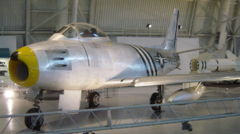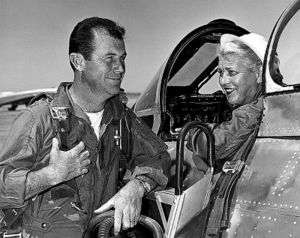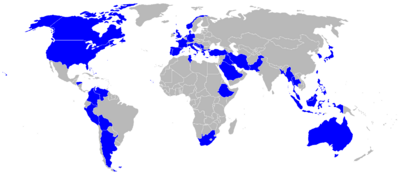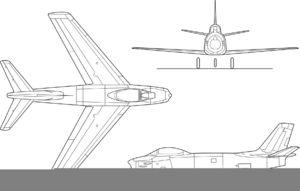PlaneSpottingWorld welcomes all new members! Please gives your ideas at the Terminal.
F-86 Sabre
| F-86 Sabre | |
|---|---|
| A North American F-86 during the Oshkosh Airshow | |
| Type | Fighter aircraft |
| Manufacturer | North American Aviation |
| Maiden flight | 1 October 1947 |
| Introduced | 1949, USAF |
| Retired | 1980, Portugal |
| Primary users | United States Air Force Pakistan Air Force Portuguese Air Force Argentine Air Force |
| Number built | 9,860 |
| Unit cost | US$219,457 (F-86E)[1] US$343,839 (F-86D) |
| Developed from | FJ Fury |
| Variants | Canadair Sabre North American YF-93 |
The North American F-86 Sabre (sometimes called the Sabrejet) was a transonic combat aircraft developed for the US Air Force. The F-86 was developed in the 1940s following the end of World War II and was one of the most-produced western jet fighters in the Cold War era.
Contents
Design and development
Initial proposals to meet a USAAF requirement for a single-seat high-altitude day fighter aircraft/escort fighter/fighter bomber were made in late 1944, and were derived from the design of the straight-wing FJ Fury being developed for the US Navy. [2] Performance requirements were met by incorporating a 35 degree swept-back wing with a automatic slats [3]into the design. Manufacture was not begun until after World War II as a result. The XP-86 prototype, which would become the F-86 Sabre, first flew on 1 October 1947[4].
The USAF Strategic Air Command had F-86 Sabres in service from 1949 through 1950. The F-86s were assigned to the 22nd Bomb Wing, the 1st Fighter Wing and the 1st Fighter Interceptor Wing [5].
The F-86 was manufactured as both a fighter-interceptor and fighter-bomber. Several variants were introduced over its production life, with improvements and different armaments implemented (see below). As an example, the J47-GE-7 engine of the F-86A produced a thrust of only 5,200 lbf (23 kN) while the General Electric J73-GE-3 engine of the F-86h produced 9,250 lbf of thrust [10]. The F-86 was the primary US air-combat fighter during the Korean War, with significant numbers of the first three production models seeing combat.
The fighter-bomber version (F-86H) could carry up to 2,000 pounds (900 kg) of bombs, including an external fuel-type tank that could carry napalm [6]. Both the interceptor and fighter versions carried six Browning M3 .50 in (12.7 mm) caliber machine guns in the nose (later versions of the F-86H carried four 20 mm cannons instead of machine guns). Guns were harmonized to converge at 1,000 feet (300 m) in front of the aircraft with one tracer bullet for every five rounds. Most rounds used during the Korean War were API (armor-piercing incendiary) bullets containing magnesium, which were designed to ignite upon impact but performed poorly above 35,000 feet.[citation needed] Unguided 2.75 inch (70 mm) rockets were used on some of the fighters in target practice, but 5 inch (127 mm) rockets were later used in combat operations. The planes could also be fitted with a pair of external jettisonable fuel tanks (four on the F-86F beginning in 1953) that extended the range of the aircraft.
The F-86 Sabre was also license produced by Canadair Limited in Montreal as the Canadair Sabre. The final variant of the Canadian Sabres, the Mk 6, is generally rated as being one of the most capable of all Sabre variants built anywhere.[7] The last Sabre to be manufactured by Canadair Ltd. (Sabre #1815) now resides at the Western Canada Aviation Museum (WCAM)'s permanent collection in Winnipeg, Canada after being donated by the Pakistan Air Force[8].
Combat service
Korean War
By the end of hostilities, the F-86 had shot down 792 MiGs at a loss of only 76 Sabres, a victory ratio of 10 to 1. In the hands of skillful pilots, the Sabre's 10-1 kill ratio over the MiG-15 was the best achieved in any sustained fighter campaign. Of the 40 pilots to earn the designation of "ace" (five or more kills) during the Korean war, all but one flew the F-86 Sabre.
The F-86 entered service with the United States Air Force in 1949, joining the 1st Fighter Wing's 94th Fighter Squadron "Hat-in-the-Ring" and became the primary air-to-air jet fighter used in the Korean War. With the introduction of the Soviet Mikoyan-Gurevich MiG-15 into air combat in November 1950, in which it out-performed all aircraft then assigned to the United Nations, three squadrons of F-86s were rushed to the Far East in December [[11]]. The F-86 could out turn and out dive the MiG-15, but the MiG-15 was slightly superior to the F-86 in ceiling, acceleration, rate of climb, and zoom (until the introduction of the F-86F in 1953); and flown from bases in Manchuria by Soviet VVS pilots, was pitted against two squadrons of the 4th Fighter-Interceptor Wing forward-based at K-14, Kimpo, Korea [[12]].
Many of the American pilots were experienced World War II veterans while the North Koreans and the Chinese lacked combat experience thus accounting for much of the F-86's success in achieving air superiority during nearly all of the hostilities [13]. F-86 pilots also achieved a favorable kill ratio even over the Soviet piloted MiG-15s. Although Soviets piloted the majority of MiG-15s that fought in Korea, North Korean and Chinese pilots with inferior skills and training were responsible for piloted the remainder[14][15]. The Soviets and their allies periodically contested air superiority in MiG Alley, a hotbed for air-to-air combat near the mouth of the Yalu River (the boundary between Korea and China). The F-86E's all-moving tailplane has been credited with giving the Sabre a decisive advantage over the MiG-15.[citation needed] Far greater emphasis has been given to the training, aggressiveness and experience of the F-86 pilots. [[16]] Despite rules-of-engagement to the contrary, F-86 units frequently initiated combat over MiG bases in the Manchurian "sanctuary" [[17]].
Only 147 USAF aircraft were downed due to air-to-air combat while approximately 1466 other USAF aircraft were attributed to various other enemy action while 975 Chinese/Soviet/North Korean aircraft were claimed shot down by the USAF Far Eastern Air Force (FEAF). [9][10]. USAF records also show 224 F-86s lost to all causes, including non-combat. The Russian list of air to air kill claims may be found here [[18]]
The needs of combat operation balanced against the need to maintain an adequate force structure in Western Europe led to the conversion of the 51st Fighter-Interceptor Wing from the F-80 to the F-86 in December 1951. Two fighter-bomber wings, the 8th and 18th, converted to the F-86F in the spring of 1953. The 2 Squadron SAAF also distinguished itself flying F-86s in Korea as part of the 18 FBW.[citation needed]
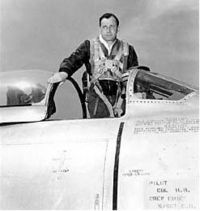
Notable F-86 aces include:
- Captain Joseph C. McConnell (16 victories), 51 FIW, who later died in a crash at Edwards Air Force Base testing the F-86H
- Major James Jabara (15 credits), 4 FIW
- Captain Manuel "Pete" Fernandez, (14.5 victories), 4 FIW
- Major George Davis (14 victories), 4 FIW, awarded the Medal of Honor posthumously
- Colonel Royal Baker (13 credits), 4 FIW group commander, 540 combat missions flown in three wars
- Major General Frederick "Boots" Blesse (ten victories), 4 FIW, noted air tactics author
- Colonel Francis S. "Gabby" Gabreski (six and one-half victories), 51 FIW commander, top European U.S. ace in World War II
- Captain Iven Kincheloe (five victories) 51 FIW, test pilot selected to fly the X-15
- Colonel Harrison R. Thyng (5 victories), 4 FIW commander
Others who flew the F-86 in combat include future astronaut and U.S. Senator Major
John Glenn, a Marine Corps exchange pilot with the 51 FIW; Colonel Walker "Bud" Mahurin, 51st Group commander and WWII ace; Captain James Horowitz with the 4 FIW, novelist and author of The Hunters under the pen name James Salter; Squadron Leader Graham Hulse RAF, exchange pilot with the 4 FIW.[citation needed]
1958 Taiwan Strait Crisis
The Republic of China Air Force of Taiwan was one of the first recipients of surplus USAF Sabres. From December 1954 to June 1956, the ROC Air Force received 160 ex-USAF F-86F-1-NA through F-86F-30-NA fighters. By June of 1958, the Nationalist Chinese had built up an impressive fighter force, with 320 F-86Fs and seven RF-86Fs having been delivered.[citation needed]
Sabres and MiGs were shortly to battle each other in the skies of Asia once again in the Second Taiwan Strait Crisis. In August of 1958, the Chinese Communists of the People's Republic of China attempted to force the Nationalists off of the islands of Quemoy and Matsu by shelling and blockade. Nationalist F-86Fs flying CAP over the islands found themselves confronted by Communist MiG-15s and MiG-17s, and there were numerous dogfights.
During these battles, the Nationalist Sabres introduced a new element into aerial warfare — under a secret effort designated Operation Black Magic, the US Navy had provided the ROC with the AIM-9 Sidewinder, its first infrared-homing air-to-air missile, which was just entering service with the United States. A small team from VMF-323, a Marine FJ-4 Fury squadron with later assistance from China Lake and North American initially modified 20 of the F-86 Sabres to carry a pair of Sidewinders on underwing launch rails and instructed the ROC pilots in their use flying profiles with USAF F-100s simulating the MiG-17. The MiGs enjoyed an altitude advantage over the Sabres as they had in Korea and Communist Chinese MiGs routinely cruised over the Nationalist Sabres, only engaging when they had a favorable position. The Sidewinder took away that advantage and proved to be devastatingly effective against the MiGs.[11]
The combat introduction of the Sidewinder took place in a battle on 24 September 1958 when ROC Sabres succeeded in destroying ten MiGs and scoring two probables without loss to themselves.[citation needed] In one month of air battles over Quemoy and Matsu, Nationalist pilots tallied a score of no less than 29 MiGs destroyed and eight probables, against a loss of two F-84Gs and no Sabres.[citation needed]
Indo-Pakistani War of 1965
The F-86 entered service with the Pakistan Air Force (PAF) in 1954 with the first batch of 120 aircraft. Most of the aircraft were of the F-86F-40 configuration except for a few which were of the F-86F-35 standard. The F-86 has been operated by PAF squadrons 5, 11, 14, 15, 16, 17, 18, 19 and 26 at different times. During the Indo-Pakistan war of 1965 the F-86 became the mainstay of the PAF and provided a qualitative edge[12] against a larger Indian Air Force (IAF).
In the air-to-air combat of the Indo-Pakistani War of 1965, the PAF Sabres claimed to have shot down 15 IAF aircraft, comprising of nine Hunters, four Vampires and two Gnats[13]. India however, admitted a loss of 14 combat aircraft to the PAF's F-86s[14]. The F-86s of the PAF had the advantage of being armed with AIM-9B/GAR-8 Sidewinder missiles whereas none of its Indian adversaries had this capability. Despite this, the IAF claimed to have shot down 13 PAF Sabres in Air-to-air combat[15]. This claim is disputed by the PAF who admit to having lost 13 F-86s Sabres during the whole 23 days Indo-Pakistani War of 1965 but only seven of them during Air to Air battles [13].
The PAF Sabres performed well in ground attack with claims of destroying around 36 aircraft on the ground at Indian airfields at Halwara, Kalaikunda, Baghdogra, Srinagar and Pathankot [13][19][20][21]. India disputes these claims and admits to having lost around 22 aircraft on the ground to strikes partly attributed to the PAF's F-86s and its bomber B-57 Canberra[14].
Pakistani F-86s were also used against advancing columns of the Indian army when Sabres from the No. 19 Squadron engaged ground forces of the Indian Army using five inch rockets along with their six Browning M3 .50 in (12.7 mm) caliber machine guns. According to Pakistan reports, Indian armor bore the brunt of this particular attack at Wagah.[22]. The Number 14 Squadron of the PAF, operating the F-86 Sabre, earned the nickname "Tailchoppers" in PAF for their actions and bravery during the Indo-Pakistani War of 1965[23].
During the war, United States barred the sales of the F-86 to Pakistan. Nonetheless, Pakistan maintained its F-86 fleet through sales of around 90 Iranian Sabres and Sabre Mk 6 CL-13s (Canadian-made F-86 Sabres) which formed the backbone of the operations during the Indo-Pakistan War of 1971.[citation needed] Despite its formidability the F-86 proved vulnerable to the diminutive Folland Gnat, which proved to be fast, nimble and hard to see. The Gnats, which claimed to have downed seven PAF Sabres, were given the nickname "Sabre Slayer" by the Indian Air Force.[15][16] However the Pakistan Air Force disputes this claim and accepts the loss of only three F-86 Sabres at the hands of the Gnats[13]
Claimed F-86 Ace:
- Sqn Ldr Muhammad Mahmood Alam who is officially credited by the PAF with five kills in Air to Air combat. However, he claimed nine aircraft[17] three of them reportedly in less than a minute.[24]. This claim is disputed by India, who give him credit for four kills. [25]
1971 Indo-Pakistani War
The Canadair Sabres (Mark 6) acquired from ex-Luftwaffe stocks via Iran, was the mainstay of the PAF's day fighter operations during the Indo-Pakistan War of 1971 and had the challenge of dealing with the threat from IAF.[citation needed] Despite having acquired newer plane types such as the Mirage III and the Shenyang F-6, the Sabre Mark VI (widely regarded as the best "dog-fighter" of its era[18]) along with the older F-86Fs of the PAF were tasked with the majority of operations during the war due to the small numbers of the Mirages and combat unreadiness of the Shenyang F-6[8] In East Pakistan only one squadron (14th Squadron) of F-86s was deployed by the Pakistan Air Force, which had to face the formidable Soviet MiG-21s and the Sukhoi SU-7 acquired by the Indian Air Force and the numerical superiority of the IAF. At the beginning of the war, PAF had eight squadrons of F-86 Sabres.[19]
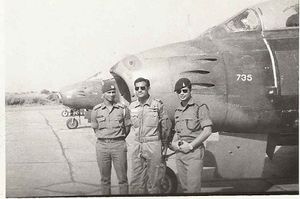
Despite these challenges the F-86 is believed by PAF to have performed well with Pakistani claims of downing 31 Indian aircraft, at the hands of the Sabre, in air-to-air combat including 17 Hawker Hunters, 7 Sukhoi SU 7 'Fitters', 2 MiG 21s and 3 Gnats[20] while losing 7 F-86s in return [21]. India however claims to have shot down 11 PAF Sabres for the loss of 11 combat aircraft to the PAF F-86s [22] in Air-to-air combat. The combined might of the IAF however, overwhelmed the sole East Pakistan squadron of Sabres and other military aircraft[23][24] which were either shot down, or grounded by Pakistani Fratricide as they could not hold out, enabling complete Air superiority for the Indian Air Force.[25]
The first notable air engagement over East Pakistan was the Battle of Boyra where, according to Indian claims, 4 Gnats downed 3 Sabres. Pakistan Air Force disputes this and claims that 2 Sabres were lost and 1 Folland Gnat shot down.[8]. As per official Pakistan accounts, 24 Sabres were lost in the war: 13 due to enemy action and 11 which were self disabled by PAF on the ground so as to keep them out of enemy hands.[21], while 28 Sabres were lost as per Indian accounts: 17 due to IAF action and 11 self disabled by PAF on the ground to keep them out of enemy hands.[26]. Five of these Sabres, however, were recovered in working condition and flown again by the Bangladesh Air Force.[26][27][28]
After this war, Pakistan slowly phased out its F-86 Sabres and replaced them with Chinese F-6 (Russian MiG-19 based) fighters. The last of the Sabres were withdrawn from service in PAF in 1980.[8] F-86 Sabres nevertheless remain a legend in Pakistan and are seen as a symbol of pride. They are now displayed in Pakistan Air Force Museum and in the cities to which their pilots belonged.
Argentina
A total of 28 surplus F-86Fs were sent to the Fuerza Aérea Argentina (FAA) in 1960. The first of these were received on September 26, 1960. FAA Sabres saw action in helping to foil an April 1962 coup attempt against the established government. The FAA Sabres attacked the Navy base at Punta Indio and destroyed a Navy C-54 on the ground, helping to quash the coup.[citation needed] Argentina attempted to sell F-86Fs to Venezuela in 1976, but the deal was embargoed by the United States (the original owner of the planes).[citation needed] The planes were then offered to Uruguay, but the deal fell through just before they were scheduled to be delivered.[citation needed] During the Falklands War of 1982, there was some talk of FAA Sabres being deployed to Port Stanley, but this idea was deemed impractical.[citation needed]
Australia
The Royal Australian Air Force purchased 112 locally manufactured examples of the Sabre, based on the F-86F, and designated the CAC CA27.[citation needed] This Sabre was fitted with a Rolls-Royce RA.7 Avon Mk26 engine, armed with twin 30mm ADEN cannons and from 1959 with AIM-9 Sidewinder missiles, resulting in major modifications to the original Sabre design. The RAAF operated the Avon-Sabre from 1956 to 1971.[29]
Portugal
In 1958, the Força Aérea Portuguesa (FAP) received 50 F-86Fs from ex-USAF stocks. A small number of former Royal Norwegian Air Force F-86Fs were also purchased as spares in 1968-69. All of them were brought up to F-86F-40 standards, including Sidewinder capability.[citation needed] Two Portuguese squadrons (Esc. 51 and 52, at BA5 Monte Real) operated these Sabres. In August of 1961, eight FAP Sabres were deployed to Portuguese Guinea in a show of force against the insurgents. They ended up staying for three years, flying ground attack and close support missions against the rebels. They were withdrawn from Guinea in October of 1964. The last six FAP Sabres were withdrawn in July of 1980.[citation needed]
South Africa
During the Korean War, the South African Air Force operated 22 F-86F-30-NA Sabres on loan from the USAF. They flew with No. 2 "Cheetah" Squadron in Korea, which was attached to the 18th FBW of the USAF, carrying out 2,032 combat sorties during the last few months of the Korean War. Six were written off during action. Following the end of the Korean War, the SAAF Sabres were returned to the USAF, and were transferred to Taiwan via MAP. To replace them, 34 Canadair Sabre Mk 6s were delivered to the SAAF in April of 1954.[citation needed]
Venezuela
The Fuerzas Aereas Venezolanas received 30 ex-USAF F-86Fs in 1955-60. These were operated by Grupo Area de Caza No. 12, Escuadron de Caza 36 Jaguares and possibly also by Escuadron de Cazas 37 and 38. These operated alongside F-86Ks acquired from Luftwaffe surplus stocks. Four FAV F-86Fs participated in an abortive coup in 1958, strafing the presidential palace in Caracas. Six F-86Fs were lost in accidents. Most surviving F-86Fs were grounded in 1969. The F-86Fs were retired in 1971, nine going to Bolivia.[citation needed]
Breaking the sound barrier
The F-86 may have been the first aircraft to break the sound barrier.[citation needed]. Although a subsonic aircraft in level flight, like several other subsonic aircraft, it is capable of breaking the sound barrier in a dive.
Several people involved with the development of the F-86, including the chief aerodynamicist for the project and one of its other test pilots, claimed that North American test pilot George Welch actually broke the sound barrier while in a dive on the first test flight (October 1, 1947), 14 days before Chuck Yeager went supersonic in the rocket powered Bell X-1 (the X-1 was the first aircraft to sustain supersonic speeds in level flight making it the first true supersonic aircraft).[citation needed] Although this claim is not officially recognized (and never could be because it was not properly measured and witnessed) it is also not officially disputed. The F-86 first officially broke the sound barrier on 26 April 1948. On 18 May 1953, Jacqueline Cochran flying a Canadian-built F-86E alongside Chuck Yeager, became the first woman to break the sound barrier [1].
Costs
The costs are in approximately 1950 United States dollars and have not been adjusted for inflation.[1]
| F-86A | F-86D | F-86E | F-86F | F-86H | F-86K | F-86L | |
|---|---|---|---|---|---|---|---|
| Program R&D cost | 4,707,802 | ||||||
| Airframe | 101,528 | 191,313 | 145,326 | 140,082 | 316,360 | 334,633 | |
| Engine | 52,971 | 75,036 | 39,990 | 44,664 | 214,612 | 71,474 | |
| Electronics | 7,576 | 7,058 | 6,358 | 5,649 | 6,831 | 10,354 | |
| Armament | 16,333 | 69,986 | 23,645 | 17,669 | 27,573 | 20,135 | |
| Ordnance | 419 | 4,138 | 3,047 | 17,117 | 4,761 | ||
| Flyaway cost | 178,408 | 343,839 | 219,457 | 211,111 | 582,493 | 441,357 | 343,839 |
| Maintenance cost per flying hour | 135 | 451 | 187 |
Production history
North American F-86
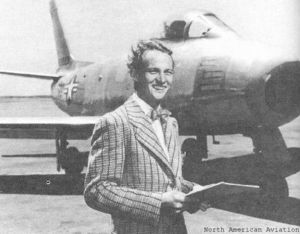
- XF-86
- three prototypes, originally designated XP-86, North American model NA-140
- YF-86A
- this was the first prototype fitted with a General Electric J47 turbojet engine.
- F-86A
- 554 built, North American model NA-151 (F-86A-1 block and first order of A-5 block) and NA-161 (second F-86A-5 block)
- DF-86A
- A few F-86A conversions as drone directors
- RF-86A
- 11 F-86A conversions with three cameras for reconnaissance
- F-86B
- 188 ordered as upgraded A-model with wider fuselage and larger tires but delivered as F-86A-5, North American model NA-152
- F-86C
- original designation for the YF-93A, two built, order for 118 cancelled, North American model NA-157
- YF-86D
- prototype all-weather interceptor originally ordered as YF-95A, two built but designation changed to YF-86D, North American model NA-164
- F-86D
- Production interceptor originally designated F-95A, 2,506 built: North American model NA-165 (F-86D-1 through D-15 blocks), NA-177 (F-86D-20 and first order of D-25 blocks), NA-173 (second order of F-86D-25 and D-30 through D-35 blocks), NA-190 (F-86D-45 and D-50 blocks) and NA-201 (F-86D-55 and D-60 blocks). The F-86D had only 25 percent commonality with other Sabre variants, marked by a larger fuselage to house a radome and larger afterburning engine.
- F-86E
- Improved flight control system and an all-flying tail; 456 built, North American model NA-170 (F-86E-1 and E-5 blocks), NA-172, essentially the F-86F airframe with the F-86E engine (F-86E-10 and E-15 blocks); 60 of these built by Canadair for USAF (F-86E-6)
- F-86E(M)
- Designation for ex-RAF Sabres diverted to other NATO air forces
- QF-86E
- Designation for surplus RCAF Sabre Mk. Vs modified to target drones
- F-86F
- Uprated engine and larger "6-3" wing without leading edge slats, 2,239 built; North American model NA-172 (F-86F-1 through F-15 blocks), NA-176 (F-86F-20 and -25 blocks), NA-191 (F-86F-30 and -35 blocks), NA-193 (F-86F-26 block), NA-202 (F-86F-35 block), NA-227 (first two orders of F-86F-40 blocks comprising 280 aircraft which reverted to leading edge wing slats of an improved design), NA-231 (70 in third F-40 block order), NA-238 (110 in fourth F-40 block order), and NA-256 (120 in final F-40 block order); 300 additional airframes in this series assembled by Mitsubishi in Japan for Japanese Air Self-Defense Force
- QF-86F
- About 50 former JASDF F-86F airframes converted to drones for use as targets by the U.S. Navy
- RF-86F
- Some F-86F-30s converted with three cameras for reconnaissance; also eighteen JASDF aircraft similarly converted
- TF-86F
- Two F-86F converted to two-seat training configuration with lengthened fuselage and slatted wings under North American model NA-204
- F-86G
- Provisional designation for F-86D variant with uprated engine and equipment changes, 406 built as F-86D models
- YF-86H
- Extensively redesigned fighter-bomber model with deeper fuselage, uprated engine, longer wings and power-boosted tailplane, two built as North American model NA-187
- F-86H
- Production model, 473 built, with Low Altitude Bombing System (LABS) and provision for nuclear weapon, North American model NA-187 (F-86H-1 and H-5 blocks) and NA-203 (F-86H-10 block)
- QF-86H
- Target conversion of 29 airframes for use at United States Naval Weapons Center
- F-86J
- Single F-86A-5-NA, serial 49-1069, flown with Orenda turbojet under North American model NA-167 - same designation reserved for A-models flown with the Canadian engines but project not proceeded with
- YF-86K
- Basic version of F-86D intended for export with rocket tray replaced by four 20 mm cannon and simplified fire control system, two conversions
- F-86K
- NATO version of F-86D with 120 built by North American and 221 kits for assembly by Fiat, North American model NA-222 (first 50 as F-86K-NF), NA-213 (F-86K-13 through K-19 blocks) and NA-221 (125 F-86K-NF assembled by Fiat) and NA-242 (final 45 F-86K-NF assembled by Fiat)
- F-86L
- Upgrade conversion of F-86D with new electronics, extended wingtips and wing leading edges, revised cockpit layout and uprated engine with reheat, 981 converted
CA-27 Sabre
The type was produced under licence by the Commonwealth Aircraft Corporation (CAC) in Australia as the CA-27 Sabre, re-engined with the Rolls-Royce Avon and armed with 30mm Aden cannons for the RAAF:
- CA-26 - one built as prototype with imported engine
- Sabre Mk 30 - 21 built, wing slats, Avon 20 engine
- Sabre Mk 31 - 21 built, 6-3 wing, Avon 20 engine
- Sabre Mk 32 - 69 built, 4 wing pylons, F-86F fuel capacity, Avon 26 engine
Canadair Sabre
The F-86 was also manufactured by Canadair in Canada as the CL-13 Sabre to replace its de Havilland Vampires, with the following production models:
- Sabre Mk 1
- one built, prototype F-86A
- Sabre Mk 2
- 350 built, F-86E-type, 60 to USAF, three to RAF, 287 to RCAF
- Sabre Mk 3
- one built in Canada, test-bed for the Orenda jet engine
- Sabre Mk 4
- 438 built, production Mk 3, 10 to RCAF, 428 to RAF as Sabre F 4
- Sabre Mk 5
- 370 built, F-86F-type with Orenda engine, 295 to RCAF, 75 to Luftwaffe
- Sabre Mk 6
- 655 built, 390 to RCAF, 225 to Luftwaffe, six to Colombia and 34 to South Africa
See also FJ Fury for production figures of USN versions.
NAA built a total of 6,297 F-86s and 1,115 FJs. Canadair built 1,815; CAC 112, Fiat 221, and Mitsubishi 300, for a total Sabre/Fury production of 9,860.
Operators
- Template:ARG: Fuerza Aérea Argentina
- Template:AUS: Royal Australian Air Force
- Template:BGD: Bangladeshi Air Force
- Template:BOL: Fuerza Aérea Boliviana
- Template:BMA
- Template:CAN: Royal Canadian Air Force
- Template:COL: Fuerza Aérea Colombiana
- Template:DNK: Royal Danish Air Force
- Template:ETH: Ethiopian Air Force
- Template:FRA: Armée de l'Air
- Template:GER: Luftwaffe
- Template:GRC: Greek Air Force
- Template:HON: Fuerza Aérea Hondureña
- Template:IDN: Indonesian Air Force
- Template:IRN: Imperial Iranian Air Force
- Template:IRQ: Iraqi Air Force
- Template:ITA: Aeronautica Militare
- Template:JPN: Japanese Air Self-Defense Force
- Template:MYS: Royal Malaysian Air Force
- Template:NLD: Royal Netherlands Air Force
- Template:NOR: Royal Norwegian Air Force
- Template:PAK: Pakistani Air Force
- Template:PER: Fuerza Aérea del Perú
- Template:PHL: Philippine Air Force
- Template:PRT: Força Aérea Portuguesa
- Template:ROC: Republic of China Air Force
- Template:SAU: Royal Saudi Air Force
- Template:Country data South Africa: South African Air Force
- Template:ROK: Republic of Korea Air Force
- Template:SPA: Ejército del Aire
- Template:THA: Royal Thai Air Force
- Template:TUN: Tunisian Air Force
- Template:TUR: Turkish Air Force
- Template:UK: Royal Air Force
- Template:USA: US Air Force, US Marine Corps, US Navy
- Template:VEN: Fuerza Aérea Venezolana
- Template:YUG: SFR Yugoslav Air Force
Several Sabres are still held by private owners (most notably actor Michael Dorn[citation needed]), including a handful that still fly at airshows and aviation events.
Specifications (F-86H)
Data from Quest for Performance[30]
General characteristics
- Crew: 1
- Length: 37 ft 6 in (11.4 m)
- Wingspan: 37 ft 1 in (11.3 m)
- Height: 14 ft 8 in (4.5 m)
- Wing area: ft² (m²)
- Empty weight: lb (kg)
- Loaded weight: 13,791 lb (6,300 kg)
- Powerplant: 1× General Electric J47 turbojet, 5,200 lbf (24 kN)
- * Zero-lift drag coefficient: 0.0132
- Drag area: 3.8 ft² (0.35 m²)
- Aspect ratio: 4.78
Performance
- Maximum speed: 685 mph (595 knots, 1,100 km/h)
- Range: 1,200 mi (1,000 nm, 1,900 km)
- Service ceiling: 49,000 ft (14,900 m)
- Rate of climb: 7,250 ft/min (36.8 m/s)
- Thrust/weight: 0.38
- Lift-to-drag ratio: 15.1
- Time to altitude: 6.3 min to 30,000 ft (9,145 m)
Armament
- Guns: 6× 0.50 in (12.7 mm) machine guns
References
- ↑ 1.0 1.1 1.2 Knaack, Marcelle Size. Encyclopedia of US Air Force aircraft and missile systems, Volume 1, Post-World War Two Fighters, 1945-1973. Washington, DC: Office of Air Force History, 1978. ISBN 0-912799-59-5.
- ↑ [1]
- ↑ [2]
- ↑ [3]
- ↑ [4]
- ↑ [5]
- ↑ Joos 1971, p.3. Note: The Canadair Sabre Mk 6 was the last variant and considered to be the "best" production Sabre ever built.
- ↑ 8.0 8.1 8.2 8.3 Pakistan Air Force - The Canadair Sabre Goes to War
- ↑ [[6]] Access date 22 February 2007
- ↑ [[7]] Access date 22 February 2007
- ↑ http://home.inreach.com/tc/page7.html
- ↑ Pakistan's Defence Journal
- ↑ 13.0 13.1 13.2 13.3 Claims and Counter Claims - PakDef.Info
- ↑ 14.0 14.1 1965 Losses
- ↑ 15.0 15.1 IAF Kills in 1965
- ↑ FOLLAND FO-141 GNAT
- ↑ Singh, Pushpindar. Fiza ya, Psyche of the Pakistan Air Force. London: Himalayan Books, 1991. ISBN 81-7002-038-7.
- ↑ Canadair CL-13 SABRE - Royal Canadian Air Force
- ↑ "India and Pakistan: Over the Edge" December 13, 1971, TIME
- ↑ PAF Kills and claims in 1971 - Pakdef.info
- ↑ 21.0 21.1 PAF Losses in 1971Pakdef.info
- ↑ IAF Losses in 1971 - Bharat Rakshak.com
- ↑ Military losses in the 1971 Indo-Pakistani war
- ↑ [8]
- ↑ Pakistan & the Karakoram Highway By Owen Bennett Jones, Lindsay Brown, John Mock and Sarina Singh, Pg 30
- ↑ 26.0 26.1 AIRCRAFT LOSSES IN PAKISTAN -1971 WAR
- ↑ Bangladesh Air Force History
- ↑ Virtual Bangladesh:Defense:Airforce
- ↑ RAAF Museum page on Sabre
- ↑ Loftin, LK, Jr. Quest for performance: The evolution of modern aircraft. NASA SP-468. [9] Access date: 22 April 2006.
- Allward, Maurice. F-86 Sabre. London: Ian Allen, 1978. ISBN 0-71100-860-4.
- Curtis, Duncan. North American F-86 Sabre. Ramsbury, UK: Crowood, 2000. ISBN 1-86126-358-9;
- Swanborough, F. Gordon. United States Military Aircraft since 1909. London: Putnam, 1963. ISBN 0-87474-880-1.
- Joos, Gerhard W. Canadair Sabre Mk 1-6, Commonwealth Sabre Mk 30-32 in RCAF, RAF, RAAF, SAAF, Luftwaffe & Foreign Service. Kent, UK: Osprey Publications Limited, 1971. ISBN 0-85045-024-1.
- Wagner, Ray. American Combat Planes - Second Edition. Garden City, New York: Doubleday and Company, 1968. ISBN 0-370-00094-3.
- Werrell, Kenneth P. Sabres Over MiG Alley. Annapolis, Maryland: Naval Institute Press , 2005. ISBN 1-59114-933-9.
- Westrum, Ron. Sidewinder. Annapolis, Maryland: Naval Institute Press, 1999. ISBN 1-55750-951-4.
External links
- Warbird Alley: F-86 Sabre page - Information about F-86s still flying today
- Sabre site
Related content
Related development
Comparable aircraft
Designation sequence
Related lists
Lists relating to aviation | |
|---|---|
| General | Timeline of aviation · Aircraft · Aircraft manufacturers · Aircraft engines · Aircraft engine manufacturers · Airports · Airlines |
| Military | Air forces · Aircraft weapons · Missiles · Unmanned aerial vehicles (UAVs) · Experimental aircraft |
| Notable incidents and accidents | Military aviation · Airliners · General aviation · Famous aviation-related deaths |
| Records | Flight airspeed record · Flight distance record · Flight altitude record · Flight endurance record · Most produced aircraft |
da:F-86 Sabre de:North American F-86 es:North American F-86 Sabre fa:اف-۸۶ سیبر fr:F-86 Sabre gl:F-86 Sabre it:North American F-86 Sabre he:F-86 סייבר ml:എഫ് 86 സേബര് ja:F-86 (戦闘機) no:North American F-86 Sabre pl:North American F-86 Sabre pt:F-86 Sabre sl:North American F-86 Sabre fi:F-86 Sabre sv:F-86 Sabre zh:F-86軍刀戰鬥機
